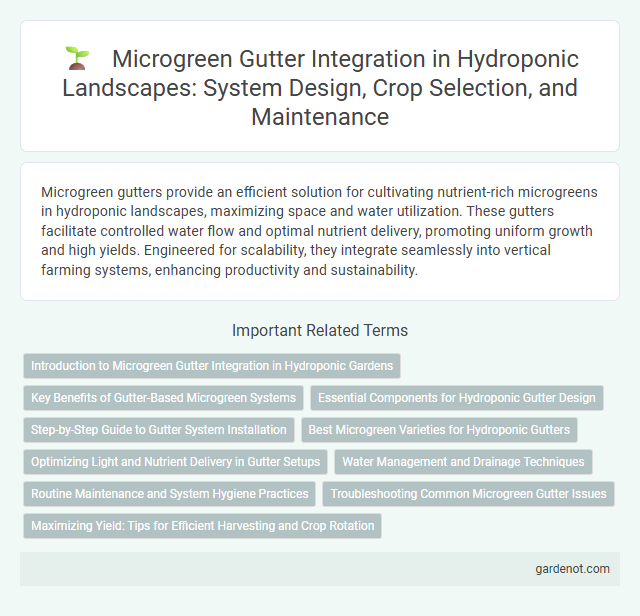Microgreen gutters provide an efficient solution for cultivating nutrient-rich microgreens in hydroponic landscapes, maximizing space and water utilization. These gutters facilitate controlled water flow and optimal nutrient delivery, promoting uniform growth and high yields. Engineered for scalability, they integrate seamlessly into vertical farming systems, enhancing productivity and sustainability.
Introduction to Microgreen Gutter Integration in Hydroponic Gardens
Microgreen gutters are specialized channels designed to optimize space and nutrient delivery in hydroponic gardens, facilitating efficient growth of nutrient-dense microgreens. These gutters enable uniform water circulation and aeration, crucial for root development and maximizing microgreen yield. Integrating microgreen gutters enhances scalability and resource management, making hydroponic setups more productive and sustainable.
Key Benefits of Gutter-Based Microgreen Systems
Gutter-based microgreen systems optimize space by enabling vertical stacking and easy expansion, making them ideal for urban and indoor hydroponic landscapes. These systems enhance water efficiency through precise nutrient delivery and reduce labor by simplifying planting, maintenance, and harvesting processes. Improved airflow and drainage in gutters help prevent disease and promote healthy microgreen growth, ensuring higher yields and consistent crop quality.
Essential Components for Hydroponic Gutter Design
Microgreen gutter design in hydroponic landscapes relies on essential components such as durable, food-grade PVC material to ensure safe plant growth and longevity. Proper slope and drainage systems are critical for optimal nutrient solution flow, preventing waterlogging and promoting healthy root development. Integrated support brackets and ventilation openings enhance stability and airflow, which are vital for maintaining microgreen vitality and maximizing yield.
Step-by-Step Guide to Gutter System Installation
Install microgreen gutter systems by first selecting lightweight, durable PVC gutters with pre-drilled holes for optimal water drainage and aeration. Securely mount the gutters on adjustable brackets spaced 12-18 inches apart to support crop density and facilitate maintenance. Connect gutters with end caps and drip irrigation tubing, ensuring a consistent nutrient solution flow for uniform microgreen growth.
Best Microgreen Varieties for Hydroponic Gutters
The best microgreen varieties for hydroponic gutters include nutrient-dense options like sunflower, pea shoots, radish, and broccoli, which thrive in controlled water-based environments. These microgreens exhibit rapid growth cycles and high yield potential, making them ideal for compact gutter systems. Selecting varieties with strong root structures and disease resistance enhances productivity and ensures consistent harvests in hydroponic gutter setups.
Optimizing Light and Nutrient Delivery in Gutter Setups
Microgreen gutter systems optimize light exposure by utilizing adjustable LED grow lights that provide consistent, spectrum-specific illumination tailored to microgreen growth stages. Nutrient delivery is enhanced through precisely controlled hydroponic nutrient film techniques, ensuring even distribution of water and essential minerals along the gutter channels. These optimized light and nutrient setups promote faster germination, higher biomass yield, and improved microgreen nutrient density.
Water Management and Drainage Techniques
Microgreen gutters optimize water management by ensuring precise irrigation delivery, reducing water waste through controlled flow systems tailored for hydroponic setups. Advanced drainage techniques prevent root saturation and microbial growth by facilitating efficient water runoff and aeration within the gutter channels. Implementing these methods enhances nutrient absorption, promotes healthy microgreen growth, and maintains system hygiene in hydroponic landscapes.
Routine Maintenance and System Hygiene Practices
Routine maintenance of microgreen gutters involves regular cleaning to prevent algae buildup and ensure optimal water flow, critical for healthy plant growth in hydroponic systems. System hygiene practices include sterilizing gutters and replacing nutrient solutions frequently to reduce pathogen risks and maintain a balanced pH level. Consistent monitoring of water quality and gutter integrity supports sustained nutrient absorption and minimizes pest infestations in hydroponic microgreen cultivation.
Troubleshooting Common Microgreen Gutter Issues
Clogging in microgreen gutters often results from debris buildup, disrupting water flow and nutrient delivery essential for healthy plant growth. Regular cleaning with a soft brush and flushing the system can prevent blockages and maintain optimal hydration levels. Ensuring proper gutter alignment and slope helps avoid water pooling and root rot, common issues that impact crop yield.
Maximizing Yield: Tips for Efficient Harvesting and Crop Rotation
Microgreen gutters enhance hydroponic landscape systems by optimizing space and nutrient delivery for maximum yield. Efficient harvesting techniques, such as cutting microgreens just above the nutrient solution, preserve root health and promote faster regrowth. Implementing strategic crop rotation minimizes pest buildup and nutrient depletion, ensuring consistent productivity and vibrant microgreen growth.
Microgreen gutter Infographic

 gardenot.com
gardenot.com